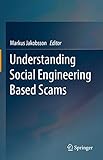Understanding Social Engineering Based Scams [electronic resource] / edited by Markus Jakobsson.
Contributor(s): Jakobsson, Markus [editor.] | SpringerLink (Online service).
Material type: BookPublisher: New York, NY : Springer New York : Imprint: Springer, 2016Description: XVI, 130 p. 51 illus., 18 illus. in color. online resource.Content type: text Media type: computer Carrier type: online resourceISBN: 9781493964574.Subject(s): Computer science | Computer security | Data encryption (Computer science) | Computer Science | Systems and Data Security | Information Systems Applications (incl. Internet) | Data EncryptionAdditional physical formats: Printed edition:: No titleDDC classification: 005.8 Online resources: Click here to access online
BookPublisher: New York, NY : Springer New York : Imprint: Springer, 2016Description: XVI, 130 p. 51 illus., 18 illus. in color. online resource.Content type: text Media type: computer Carrier type: online resourceISBN: 9781493964574.Subject(s): Computer science | Computer security | Data encryption (Computer science) | Computer Science | Systems and Data Security | Information Systems Applications (incl. Internet) | Data EncryptionAdditional physical formats: Printed edition:: No titleDDC classification: 005.8 Online resources: Click here to access online Scams and Targeting -- Identifying Scams and Trends -- Predicting Trends -- Persuasion in Scams -- Traditional Countermeasures to Unwanted Email -- Obfuscation in Spam and Scam -- Semantic Analytics of Messages -- Case Study: Sales Scams -- Case Study: Rental Scams -- Case Study: Romance Scams -- Case Study: Business Email Compromise -- Conclusion and Next Steps.
This book describes trends in email scams and offers tools and techniques to identify such trends. It also describes automated countermeasures based on an understanding of the type of persuasive methods used by scammers. It reviews both consumer-facing scams and enterprise scams, describing in-depth case studies relating to Craigslist scams and Business Email Compromise Scams. This book provides a good starting point for practitioners, decision makers and researchers in that it includes alternatives and complementary tools to the currently deployed email security tools, with a focus on understanding the metrics of scams. Both professionals working in security and advanced-level students interested in privacy or applications of computer science will find this book a useful reference.


There are no comments for this item.